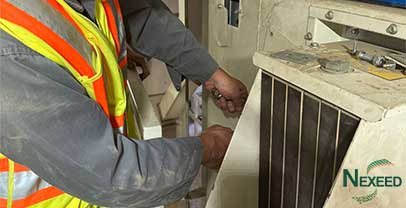The Art of Precision: Indented Cylinder Efficiently Cleans and Grades Grains
In the world of seed processing, precision is everything. Whether it’s wheat, barley, oats, fine seeds, lentils, ensuring the purity and uniformity of the final product is a top priority for producers. Enter the indented cylinder— engineering designed to clean and grade grains by length, expertly removing unwanted short admixtures while preserving the desired kernels, then lifting those desired kernels out of longer foreign material.
Nexeed proudly represents Cimbria in the Canadian market.
The Core Principle: Length Grading for Purity
The fundamental purpose of the indented cylinder is to separate grains based on their length. This is crucial because granular materials often contain impurities—such as broken kernels, weed seeds, or other short admixtures—that can compromise quality. By leveraging the physical differences in length, the indented cylinder ensures that only grains meeting the desired size specifications are saved.
Some plants and operators see the indent as a great way to eliminate wild oats from the lot. Yes, in the long grain cylinder we lift good products out of long like wild oats. If you're only doing a long grain separation, is your end product being compromised? I see plants with brands of indents that it's difficult to change cylinders (pocket size) so it doesn't happen.
1. Removal of Short Admixtures
Focusing only on long grain separation effectively removes larger contaminants like wild oats and sticks, but it leaves behind smaller impurities. Broken kernels, weed seeds (e.g., cockle or mustard seeds), and other short materials can slip through the process. These contaminants can:
- Reduce germination rates if the seeds are intended for planting.
- Lower the market grade and value of the grain for food or feed purposes.
- Affect downstream processing, such as milling or packaging, by introducing inconsistencies.
An indent cylinder, with its ability to capture and remove short grains via precision-engineered TearDrop style pockets, addresses this gap, ensuring a cleaner, more uniform product.

2. Enhanced Quality Control
Long grain separation alone doesn’t provide the full spectrum of quality control that modern seed markets demand. Buyers—whether farmers, food producers, or exporters—increasingly expect seeds free of all impurities, not just the obvious long ones. Short admixtures like broken seeds or small weed seeds can harbor pests, diseases, or mold, compromising storage life and usability. By skipping short grain separation, these plants risk delivering a product that falls short of premium standards.
3. Competitive Edge in a Demanding Market
Seed cleaning is a competitive industry, and customers are increasingly discerning. Facilities that invest in comprehensive cleaning—combining short (round), and long grain separation—can market their product as superior, meeting stricter purity and uniformity.
What owners have told me
- Having 2 cylinders doing what 6 did before is great for setting, cleanout and servicing.
- We used to not change or dread changing pocket size, now with our Cimbria its a fairly simple process so we do it, that gives us better quality.
- Round Grain Cylinder with the Teardrop pockets picks more than we ever picked before.
- Our milling lines are set up for Large Oats and Stub Oats, Our Cimbria Indents makes the separation simple and fast.

Why Length Grading Matters?
Length grading isn’t just about removing impurities—it’s about delivering consistency. Eliminating broken kernels or weed seeds that could affect seed quality. For oats, it ensures uniformity for milling or packaging. In flax and hemp , it separates damaged grains to enhance market value. For seed, it guarantees purity for planting. By targeting short admixtures, the indented cylinder safeguards both the quality and the integrity of the final product, making it an indispensable tool across the seed, ingredient and export industries.
Cimbria Heid’s Edge: In-House Manufacturing Excellence
What sets Cimbria Heid apart is our commitment to quality from the earliest stages of production. Unlike many manufacturers, we produce our own cylinder segments in-house. This hands-on approach allows us to maintain rigorous quality control and tailor each cylinder to meet specific customer needs. Our indents are meticulously crafted to maximize the number of grading pockets, optimizing efficiency and throughput. This customization ensures that whether you’re processing wheat for seed or lentils for export, our indented cylinder delivers unparalleled performance.
Reliability
With robust construction and minimal maintenance needs, it’s built to perform reliably for years. Nexeed has sold, and serviced Cimbria Heid cylinders for over 30 years. Support, troubleshooting, and parts on hand in our expanded Winnipeg parts warehouse is what these years of experience has brought us and our customers.
The Bottom Line
Seed cleaning plants that focus solely on long grain separation—targeting the removal of wild oats, sticks, and other elongated impurities are missing out.
The Missed Opportunity
In essence, these plants are addressing half the problem. Wild oats and sticks are significant, visible impurities, but the smaller, less obvious short or broken foreign material can be just as detrimental. By not integrating a tool like the indented cylinder, which excels at removing short grains, they’re leaving quality, versatility, and profitability on the table. A balanced approach—tackling both long and short impurities—ensures a cleaner, higher-value seed lot that meets the full range of customer expectations. For a seed cleaning plant, that’s not just an upgrade; it’s a game-changer.











